Planning an HVAC project requires careful consideration and effective management. By following a systematic approach, you can ensure success and efficiency in your HVAC endeavors.
Key Takeaways:
- Identify the specific requirements of the building and its occupants, including heating and cooling needs, ventilation, air quality, and humidity control.
- Choose the appropriate HVAC system based on factors such as the building’s size, location, and orientation.
- Design the HVAC system, including layout, equipment selection, and air duct design, with the help of a professional HVAC engineer.
- Prioritize energy efficiency by selecting high-efficiency equipment, designing an energy-efficient duct system, and utilizing building automation systems.
- Ensure proper installation by hiring a licensed HVAC contractor to maximize performance and longevity.
Planning a successful HVAC project involves several essential steps. The first step is to identify the specific requirements of the building and its occupants, such as heating and cooling needs, ventilation, air quality, and humidity control. Once the requirements are known, the appropriate HVAC system must be chosen, considering factors such as the building’s size, location, and orientation. The HVAC system should then be designed, including the layout of the system, selection of equipment, and design of air ducts, by a professional HVAC engineer. Energy efficiency should be prioritized during the planning process by selecting high-efficiency equipment, designing an energy-efficient duct system, and using building automation systems. Proper installation by a licensed contractor is crucial to ensure the performance and longevity of the HVAC system. Regular maintenance, including inspections and filter replacements, should be scheduled to extend the system’s lifespan. By following these steps and working with a professional team, a successful HVAC project can provide comfortable and healthy indoor air quality for building occupants.
Identifying Building and Occupant Requirements
Before diving into the planning process, it is crucial to understand the unique requirements of your building and its occupants. This initial step sets the foundation for a successful HVAC project. Begin by assessing the heating and cooling needs of the building. Consider factors such as the size of the space, number of occupants, and the level of insulation. These factors will help determine the capacity and type of HVAC system required.
Another important consideration is ventilation. Adequate airflow is essential for maintaining indoor air quality and ensuring a healthy environment. Assess the building’s ventilation requirements, taking into account factors such as the number and size of windows, the presence of exhaust systems, and the specific needs of the occupants.
Furthermore, it is essential to address air quality and humidity control requirements. Poor air quality can lead to various health issues, while improper humidity levels can cause discomfort and damage to the building materials. Assess any specific air quality requirements, such as the need for air filtration systems or the control of airborne contaminants. Additionally, determine the desired humidity levels and consider the appropriate HVAC system functionalities to achieve them.
Summary:
In order to plan an effective HVAC project, understanding the building and occupant requirements is crucial. This includes assessing heating and cooling needs, ventilation requirements, and air quality and humidity control. By gathering this information at the outset, you can ensure that the subsequent steps of system selection, design, and installation align with the unique demands of your project.
| Building and Occupant Requirements | Considerations |
|---|---|
| Heating and Cooling Needs | Assess size, occupancy, and insulation levels |
| Ventilation | Evaluate airflow requirements based on windows, exhaust systems, and occupancy |
| Air Quality and Humidity Control | Determine air quality needs and desired humidity levels |
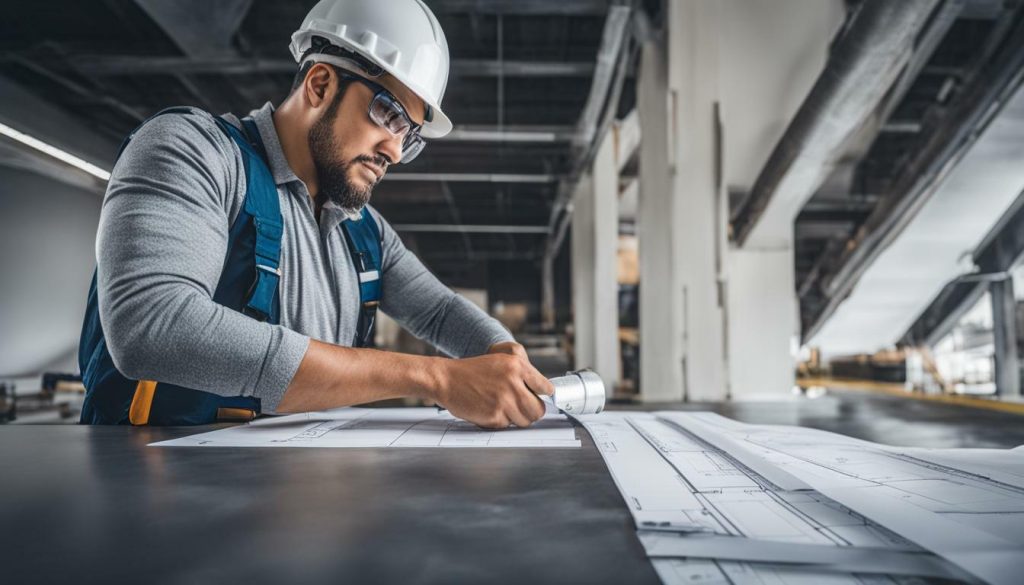
Choosing the Right HVAC System
Once the requirements are known, it is essential to carefully choose the right HVAC system that will effectively meet the needs of your building. Several factors should be considered during the selection process to ensure optimal performance and energy efficiency.
Table 1: Factors to consider when choosing an HVAC system
| Factor | Description |
|---|---|
| Building Size | The size of your building will determine the capacity of the HVAC system needed to adequately heat or cool the space. |
| Location | Consider the climate and weather patterns of your area. HVAC systems should be selected to handle the specific conditions of the location. |
| Orientation | The direction that your building faces can impact the amount of sunlight and heat it receives. This information helps determine the appropriate cooling and insulation requirements. |
| Energy Efficiency | Choose an HVAC system with a high energy efficiency rating to reduce operating costs and environmental impact. |
List 1: Steps for choosing the right HVAC system
- Assess the heating and cooling needs of your building.
- Consider the specific requirements for ventilation, air quality, and humidity control.
- Evaluate the size, location, and orientation of your building.
- Research and compare different HVAC system options based on energy efficiency ratings.
- Consult with a professional HVAC engineer to ensure accurate system sizing and selection.
By taking into account these factors and following the recommended steps, you can confidently select an HVAC system that will provide optimal comfort and efficiency for your building.
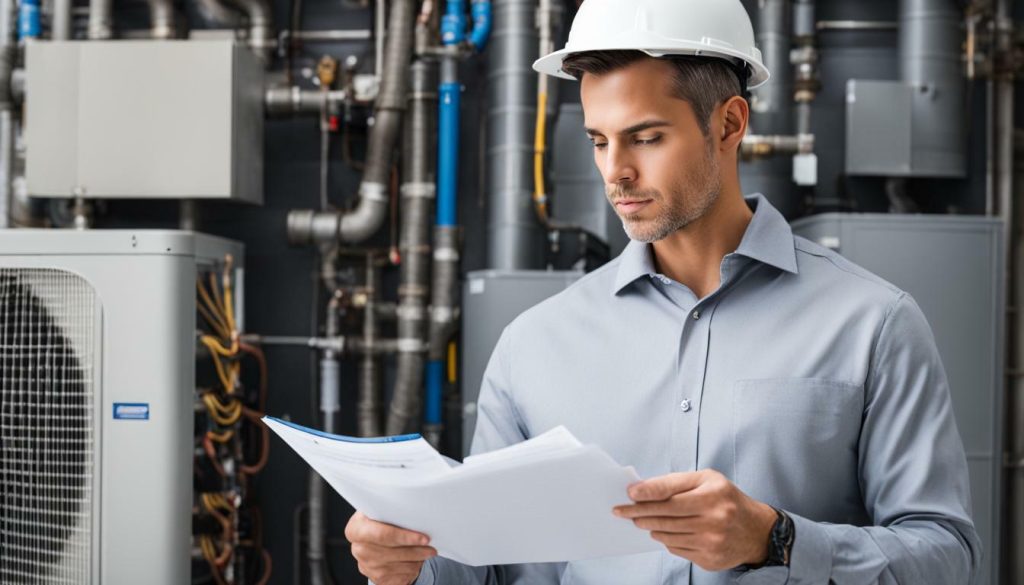
Designing the HVAC System
A well-designed HVAC system is the backbone of a successful project, ensuring optimal performance and energy efficiency. It is crucial to involve a professional HVAC engineer in the design phase to create a system that meets the specific requirements of the building and its occupants.
During the design process, careful consideration should be given to the layout of the HVAC system. This includes determining the placement of equipment, such as the furnace, air conditioning unit, and ventilation components, to maximize efficiency and minimize noise. Proper airflow and duct design should also be prioritized to ensure even distribution of conditioned air throughout the building.
In addition to the layout, equipment selection plays a critical role in the design of an HVAC system. Choosing the right size and type of equipment, such as heat pumps or air handlers, is essential to meet the heating and cooling demands of the building effectively. It is important to consider factors such as energy efficiency ratings, maintenance requirements, and compatibility with other system components.
| Design Considerations | Key Points |
|---|---|
| Layout | Maximize efficiency and minimize noise |
| Airflow and Duct Design | Ensure even distribution of conditioned air |
| Equipment Selection | Choose appropriate size and type |
By focusing on these aspects, a well-designed HVAC system can provide optimal comfort, energy efficiency, and indoor air quality for building occupants. To illustrate, consider the example below:
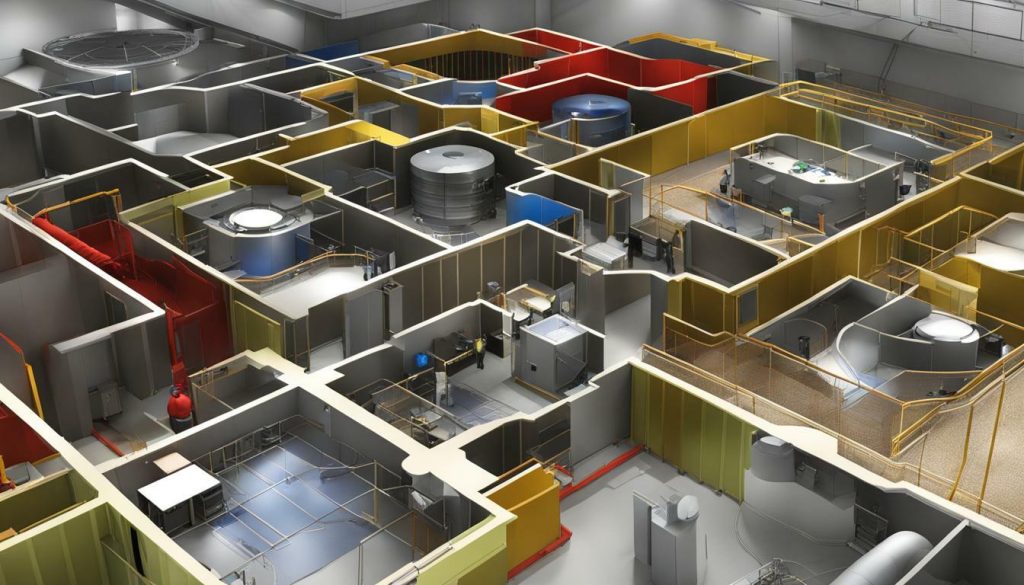
In this example, the HVAC system has been carefully designed to deliver efficient heating and cooling while maintaining a comfortable indoor environment. The layout ensures proper airflow, and the equipment selection includes a high-efficiency air conditioner and a condensing furnace. These design choices contribute to lower energy consumption and reduced utility costs, ultimately enhancing the overall performance of the HVAC system.
Remember, the design phase is a crucial step in planning an HVAC project. By working with a professional HVAC engineer and considering the key design considerations, you can ensure the successful implementation of an HVAC system that meets the unique needs of your building and its occupants.
Prioritizing Energy Efficiency
In today’s environmentally conscious world, energy efficiency plays a key role in HVAC project planning and design. By prioritizing energy efficiency, you not only reduce your environmental impact but also save on energy costs in the long run. To ensure your HVAC project is energy-efficient, here are some essential steps to follow:
- Select high-efficiency equipment: When choosing an HVAC system, opt for units with high energy efficiency ratings. Look for systems that have earned the ENERGY STAR® label, as they meet strict energy efficiency standards set by the U.S. Environmental Protection Agency. These systems are designed to consume less energy while providing optimal comfort.
- Design an energy-efficient duct system: Proper duct design is crucial for efficient HVAC operation. Ensure that the ducts are sized correctly and properly insulated to prevent air leakage. Additionally, consider using zoning systems that allow you to control the temperature in different areas of your building independently, reducing energy wastage.
- Utilize building automation systems: Implementing a building automation system (BAS) can significantly improve energy efficiency. A BAS allows you to automate and control various HVAC functions such as temperature, humidity, and ventilation. By integrating smart controls and sensors, you can optimize energy usage based on occupancy patterns, outdoor conditions, and other factors, ensuring efficient operation.
Prioritizing energy efficiency throughout the HVAC project planning process not only benefits the environment but also promotes long-term energy savings. By investing in high-efficiency equipment, designing an energy-efficient duct system, and utilizing building automation systems, you can create a sustainable and cost-effective HVAC solution for your building.
| Advantages of Energy Efficiency in HVAC Projects: | Disadvantages of Neglecting Energy Efficiency: |
|---|---|
|
|
By considering the advantages of energy efficiency and the disadvantages of neglecting it, you can make informed decisions during the HVAC project planning process. Prioritizing energy efficiency not only ensures optimal performance and comfort but also aligns with sustainable practices.
Take the Next Step Towards Energy Efficiency
To achieve maximum energy efficiency in HVAC projects, it is essential to work with experienced professionals who understand the intricacies of energy-efficient design and implementation. Their expertise will help you navigate through the different stages of project planning, from equipment selection to system installation and maintenance. By prioritizing energy efficiency, you can create a sustainable and cost-effective HVAC system that benefits the environment and your building occupants.
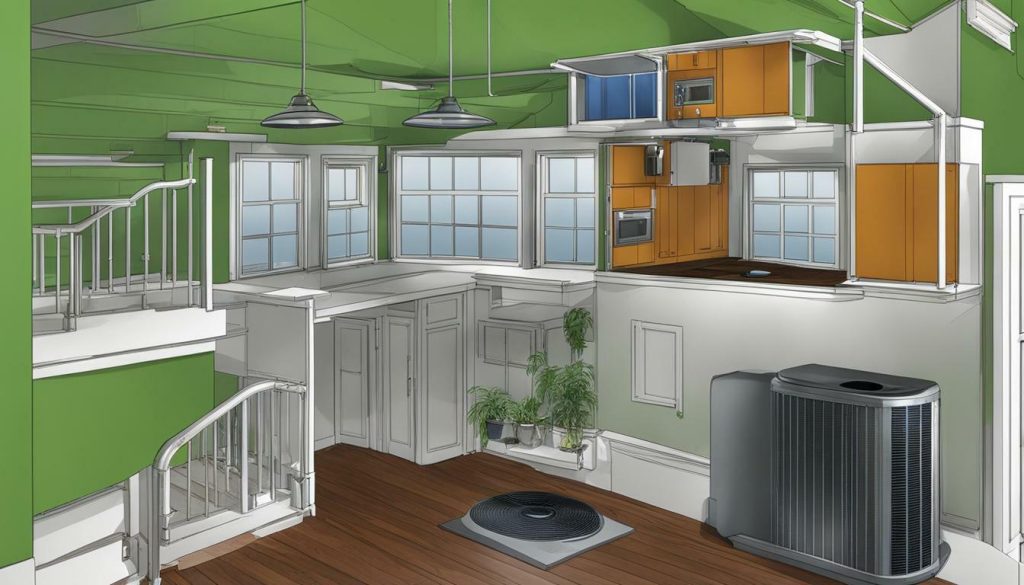
Ensuring Proper Installation
A successful HVAC project hinges on the expertise and skill of the contractor responsible for the installation. It is crucial to ensure that the HVAC system is installed correctly to maximize its performance and longevity. By following proper installation practices, you can avoid problems down the line and ensure that your HVAC system operates efficiently.
| Key Steps for Ensuring Proper Installation |
|---|
| 1. Hire a licensed HVAC contractor: |
| Make sure to work with a licensed and experienced HVAC contractor who is knowledgeable about the specific requirements of your project. A qualified contractor will have the skills and expertise to install the system correctly and troubleshoot any potential issues. |
| 2. Follow manufacturer guidelines: |
| Ensure that the installation process adheres to the manufacturer’s guidelines for the HVAC system. This includes proper placement of components, correct wiring, and appropriate sizing of ductwork. |
| 3. Test and balance the system: |
| After installation, it is essential to test and balance the HVAC system to ensure that air is distributed evenly throughout the building. This process involves adjusting dampers and registers to optimize airflow and achieve the desired comfort levels. |
| 4. Verify refrigerant charge: |
| Proper refrigerant charge is critical for the efficient operation of your HVAC system. A professional contractor will measure and verify the refrigerant charge to ensure it matches the manufacturer’s specifications. |
By following these steps, you can ensure that your HVAC system is installed correctly and functions optimally. Proper installation not only improves energy efficiency but also reduces the risk of breakdowns and costly repairs in the future. Remember to work with a licensed HVAC contractor who has the necessary expertise to complete the installation to the highest standards.
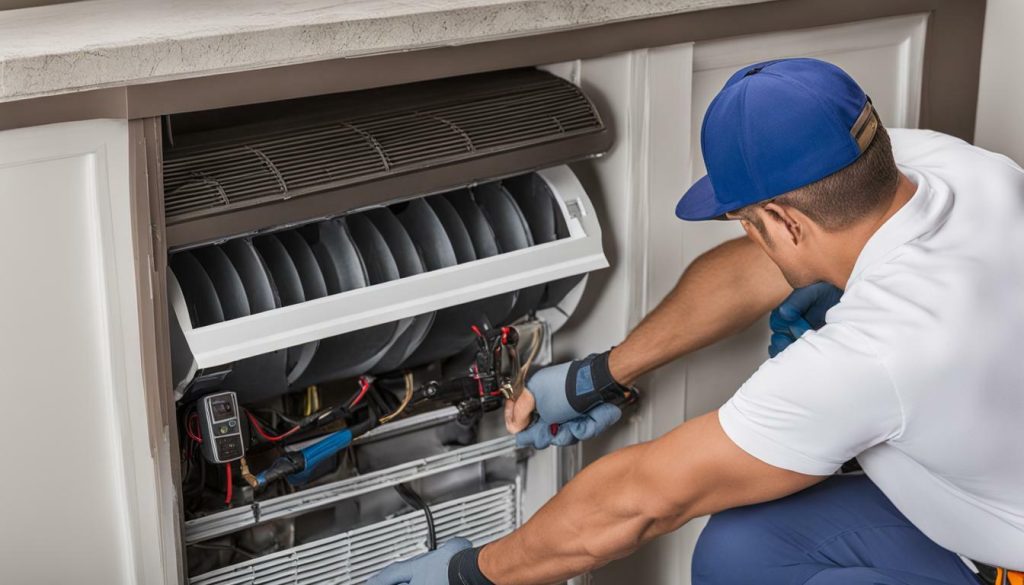
Scheduling Regular Maintenance
Proper maintenance is crucial to ensure the continued efficiency and functionality of your HVAC system. Regular inspections and filter replacements play a vital role in extending the lifespan of the equipment and preventing potential breakdowns. By scheduling routine maintenance, you can address any minor issues before they escalate into major problems, saving you both time and money in the long run.
During maintenance visits, a qualified HVAC technician will thoroughly examine your system, checking for any signs of wear and tear, leaks, or malfunctions. They will clean and lubricate components, ensuring optimal performance. Any necessary repairs or adjustments will be made promptly, restoring your system to its peak efficiency.
By investing in regular maintenance, you can also enjoy improved indoor air quality. Dirty filters and ducts can accumulate dust, allergens, and other pollutants, compromising the air you breathe. Routine filter replacements and cleaning of the ductwork will help maintain a healthy and comfortable indoor environment for you and your family.
| Benefits of Regular HVAC Maintenance | Summary |
|---|---|
| Extended lifespan of HVAC system | Your HVAC system will last longer, reducing the need for costly replacements. |
| Improved energy efficiency | Regular maintenance ensures that your system operates at its highest efficiency, keeping your energy bills in check. |
| Enhanced indoor air quality | Clean filters and ducts ensure a healthier and more comfortable indoor environment. |
| Reduced risk of breakdowns | Identifying and addressing issues early can prevent unexpected breakdowns and costly repairs. |
Don’t wait until your HVAC system stops working or starts causing discomfort. Take proactive measures by scheduling regular maintenance with a trusted HVAC service provider. Their expertise and attention to detail will keep your system running smoothly, ensuring optimal comfort and peace of mind.
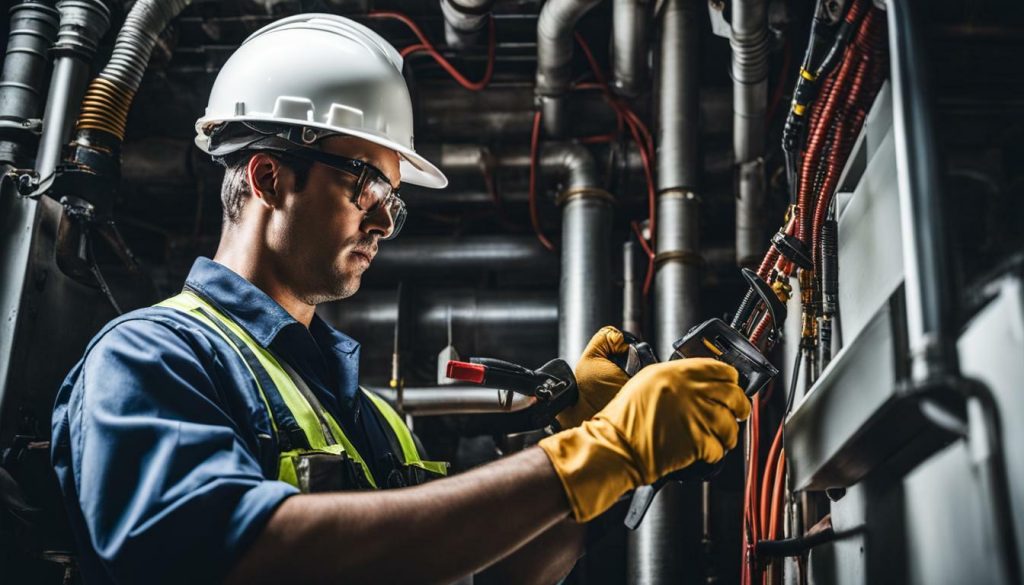
Ensuring Comfort and Air Quality
A well-planned HVAC project not only provides efficient heating and cooling but also ensures optimal comfort and air quality for building occupants. Creating a comfortable and healthy indoor environment is a crucial consideration in HVAC project planning and design. Here are some key factors to prioritize:
- Proper Airflow: Ensuring a balanced distribution of air throughout the building is essential for maintaining consistent temperatures and preventing hot or cold spots. A well-designed HVAC system should incorporate appropriate duct sizing, diffuser placement, and airflow adjustments to optimize comfort.
- Temperature Control: The HVAC system should be capable of maintaining the desired temperature levels in every area of the building. This can be achieved through proper selection and placement of heating and cooling equipment, as well as the use of thermostats and zoning systems to regulate temperature in different zones.
- Air Filtration: Clean and healthy air is vital for occupant well-being. An effective HVAC system should include high-quality air filters that capture pollutants, allergens, and other contaminants. Regular filter replacements and maintenance are necessary to uphold air quality standards.
By prioritizing these considerations, you can create a comfortable indoor environment that promotes productivity, health, and well-being. Additionally, integrating smart HVAC technologies and controls can further enhance comfort and air quality by allowing for precise adjustments and monitoring of conditions.
To illustrate the impact of HVAC planning on comfort and air quality, consider the following table showcasing the benefits of proper airflow, temperature control, and air filtration:
| Comfort and Air Quality Factors | Benefits |
|---|---|
| Proper Airflow | – Consistent temperatures throughout the building – Minimized hot or cold spots – Balanced humidity levels |
| Temperature Control | – Comfortable working or living conditions – Energy savings through optimized temperature settings – Customizable temperature zones for individual preferences |
| Air Filtration | – Removal of allergens and pollutants from the air – Improved respiratory health – Reduced risk of indoor air quality-related issues |
The Role of Professional Expertise
Collaborating with experienced professionals is essential for a seamless and successful HVAC project. With their knowledge and expertise, professionals can ensure that the project is planned and executed efficiently, meeting all necessary requirements and regulations. From the initial stages of identifying building and occupant requirements to the final installation and maintenance, their guidance is invaluable.
An HVAC project requires careful planning and design to achieve optimal comfort and air quality. Professionals in HVAC project management are equipped with the skills and expertise to assess the unique needs of a building and its occupants. They can accurately determine heating and cooling requirements, ventilation needs, and air quality considerations. Their thorough understanding of HVAC systems enables them to advise on the most suitable equipment and technologies.
During the planning and design phase, HVAC professionals play a crucial role in creating an efficient and effective system. They can design the layout of the system, selecting the appropriate equipment and designing the air ducts to ensure optimal airflow and performance. By involving a professional HVAC engineer in the design process, potential issues and inefficiencies can be identified and addressed early on, saving time and resources in the long run.
| Benefits of Professional Expertise: |
|---|
| Accurate assessment of building and occupant requirements |
| Selection of suitable HVAC equipment and technologies |
| Efficient planning and design of HVAC systems |
| Identification and resolution of potential issues |
Furthermore, professionals can ensure that energy efficiency is a priority throughout the project. They can recommend high-efficiency equipment and guide the design of an energy-efficient duct system. By integrating building automation systems, they can optimize the HVAC system’s performance, reducing energy consumption and costs.
Once the HVAC system is installed, professionals continue to play a vital role in maintaining its performance. They can schedule regular inspections and filter replacements, ensuring that the system operates at its best and maximizing its lifespan. Regular maintenance not only enhances the system’s longevity but also helps maintain optimal indoor air quality and comfort for building occupants.
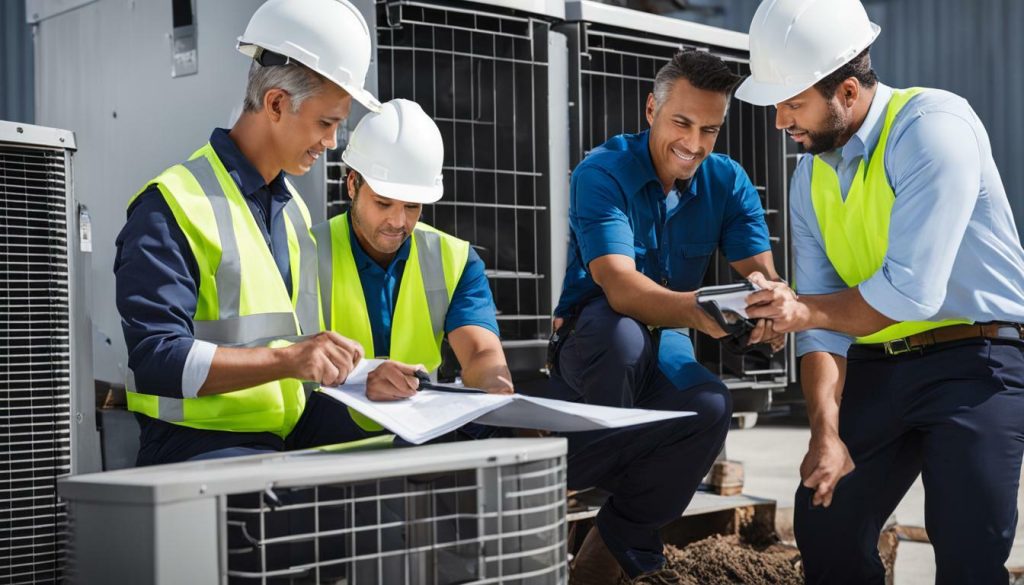
In conclusion, collaborating with experienced professionals is crucial for the successful planning and execution of an HVAC project. Their expertise in HVAC project management and design ensures that the project meets all requirements and provides optimal comfort and air quality. From the initial assessment to the final maintenance, professionals’ involvement can make a significant difference in the project’s outcome.
Conclusion
By following a systematic approach and considering the specific requirements of your building and its occupants, you can plan and execute a successful HVAC project in the United States. Planning a successful HVAC project involves several essential steps that must be carefully implemented.
The first step is to identify the specific requirements of the building and its occupants, such as heating and cooling needs, ventilation, air quality, and humidity control. Understanding these requirements is crucial in designing a system that will meet the unique needs of the space and its occupants.
Once the requirements are known, the next step is to choose the right HVAC system. Factors such as the building’s size, location, and orientation should be taken into account. Selecting the appropriate system will ensure optimal performance and energy efficiency.
The HVAC system should be designed by a professional HVAC engineer who will create the layout, select the equipment, and design the air ducts. Their expertise is essential in ensuring the system is appropriately designed and will provide efficient and reliable heating, cooling, and ventilation.
Energy efficiency should be prioritized throughout the planning process. This can be achieved by selecting high-efficiency equipment, designing an energy-efficient duct system, and utilizing building automation systems. Prioritizing energy efficiency not only reduces operational costs but also contributes to a more sustainable and environmentally friendly HVAC system.
Proper installation by a licensed contractor is crucial for the performance and longevity of the HVAC system. A well-executed installation ensures that the system operates efficiently and minimizes the risk of future malfunctions.
Scheduling regular maintenance, including inspections and filter replacements, is necessary to prolong the system’s lifespan and maintain optimal performance. By keeping the system well-maintained, you can prevent potential issues and ensure the comfort and health of the building occupants.
Lastly, it is important to work with a professional team throughout the HVAC project planning and implementation process. Their expertise and knowledge will help you navigate the complexities of the project and ensure its success.
By following these essential steps and working with industry professionals, you can achieve a successful HVAC project that provides a comfortable and healthy indoor environment for the occupants of your building.
FAQ
What are the essential steps for planning a successful HVAC project?
The essential steps for planning a successful HVAC project include identifying building and occupant requirements, choosing the right HVAC system, designing the HVAC system, prioritizing energy efficiency, ensuring proper installation, scheduling regular maintenance, ensuring comfort and air quality, and working with professional expertise.
How do I identify the specific requirements of the building and its occupants?
To identify the specific requirements of the building and its occupants, you need to consider factors such as heating and cooling needs, ventilation, air quality, and humidity control. Consulting with a professional HVAC engineer can also help determine the specific requirements.
What factors should be considered when choosing the right HVAC system?
Factors such as the building’s size, location, and orientation should be considered when choosing the right HVAC system. These factors influence the choice of the HVAC system that will best meet the building’s heating, cooling, and ventilation needs.
Why is it important to involve a professional HVAC engineer in the design phase?
Involving a professional HVAC engineer in the design phase is crucial because they have the expertise to properly design the HVAC system, including the layout, equipment selection, and design of air ducts. A well-designed system ensures optimal performance and efficiency.
How can I prioritize energy efficiency during the planning process?
Energy efficiency can be prioritized during the planning process by selecting high-efficiency equipment, designing an energy-efficient duct system, and utilizing building automation systems. These measures help reduce energy consumption and lower operating costs.
Why is proper installation by a licensed contractor important for an HVAC system?
Proper installation by a licensed contractor is crucial because it ensures that the HVAC system is installed correctly and operates at its optimal performance. Improper installation can lead to inefficient operation, higher energy costs, and potential system failures.
How often should I schedule maintenance for my HVAC system?
Regular maintenance should be scheduled for your HVAC system to ensure its longevity and optimal performance. This includes scheduling inspections and filter replacements at appropriate intervals as recommended by the manufacturer or an HVAC professional.
How does effective HVAC planning and design contribute to comfort and air quality?
Effective HVAC planning and design contribute to comfort and air quality by ensuring proper airflow, temperature control, and air filtration. Well-designed systems provide comfortable indoor environments with clean and healthy air for building occupants.
Why is working with a professional team important for a successful HVAC project?
Working with a professional team throughout the HVAC project planning and implementation process is important because professionals bring expertise and knowledge. They ensure that all aspects of the project are properly considered and executed for a successful outcome.

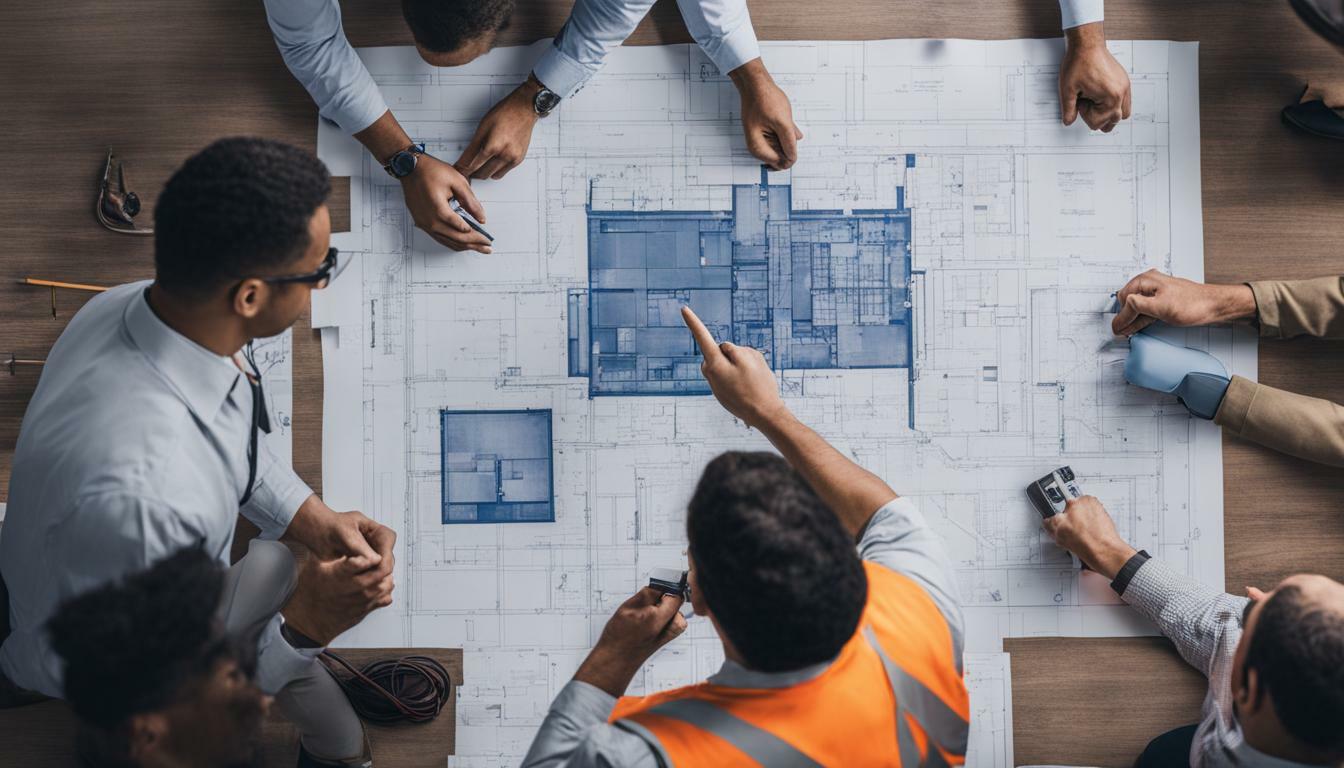



0 Comments